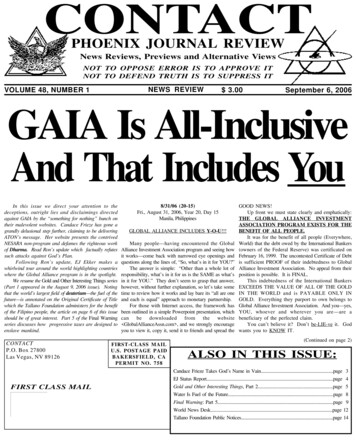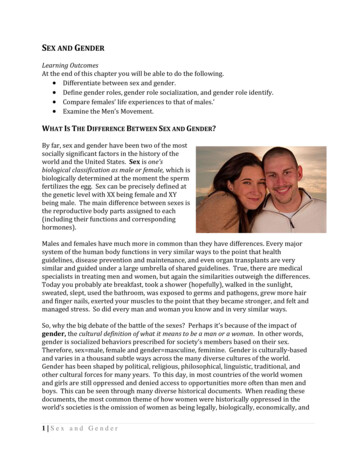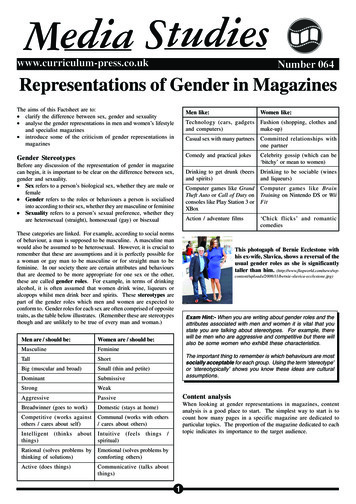
Transcription
Doing GenderCandace West; Don H. ZimmermanGender and Society, Vol. 1, No. 2. (Jun., 1987), pp. 125-151.Stable URL:http://links.jstor.org/sici?sici -WGender and Society is currently published by Sage Publications, Inc.Your use of the JSTOR archive indicates your acceptance of JSTOR's Terms and Conditions of Use, available athttp://www.jstor.org/about/terms.html. JSTOR's Terms and Conditions of Use provides, in part, that unless you have obtainedprior permission, you may not download an entire issue of a journal or multiple copies of articles, and you may use content inthe JSTOR archive only for your personal, non-commercial use.Please contact the publisher regarding any further use of this work. Publisher contact information may be obtained athttp://www.jstor.org/journals/sage.html.Each copy of any part of a JSTOR transmission must contain the same copyright notice that appears on the screen or printedpage of such transmission.The JSTOR Archive is a trusted digital repository providing for long-term preservation and access to leading academicjournals and scholarly literature from around the world. The Archive is supported by libraries, scholarly societies, publishers,and foundations. It is an initiative of JSTOR, a not-for-profit organization with a mission to help the scholarly community takeadvantage of advances in technology. For more information regarding JSTOR, please contact support@jstor.org.http://www.jstor.orgMon Nov 19 05:33:59 2007
DOING GENDERCANDACE W E S TUniuersity of California, Santa CruzDON H. ZIMMERMANUniuersity of California, Santa BarbaraT h e purpose of this article is to advance a new understanding of gender as a routineaccomplishment embedded in cvcryday interaction. T o d o so entails a criticalassessment of existing perspectives on sex and g e n h and the introduction ofimportant distinctionsamongsex, sex catcgo y,and gender. W e argue that recognitionof the analytical i n d c p u i m c e of these concepb is essential for understanding theinteractional work involved in being a gendered person in society. T h e thrust of ourremarks is toward theoretical reconccptualiration, but we c o n s i h fruitful dircctiomfor empirical research that are indicated by our formulation.I n the beginning, there was sex and there was gender. Those of uswho taught courses in the area in the late 1960s and early 1970s werecareful to distinguish one from the other. Sex, we told students, waswhat was ascribed by biology: anatomy, hormones, and physiology.Gender, we said, was a n achieved status: that which is constructedthrough psychological, cultural, and social means. T o introduce thedifference between the two, we drew o n singular case studies ofhermaphrodites (Money 1968, 1974; Money and Ehrhardt 1972) andanthropological investigations of "strange and exotic tribes" (Mead1963, 1968).Inevitably (and understandably), in the ensuing weeks of eachterm, our students became confused. Sex hardly seemed a "given" inA U T H O R S ' NOTE: T h i s article is based i n part o n a paperpresented at the AnnualMeeting of the American Sociological Association, Chicago, September1977. For thetrhelpful suggestions and encouragement, we thank Lynda Ames, Betttna Aptheker,Stcucn Clayman, Judith G o s o n , the late Ewing Goffman, Marilyn Lester, JudtthLorber, Robin Lloyd, Wayne Melltnger, Beth E. Schneido, Banie Thorne, Thornasp.Wilson, and most espectally, Sarah Fenstermaker Berk.GENDER & SOCIETY. Vol. I No. 2. Junc 1987 125.1511987 Sodologists for Worncn in Sodcty0
126GENDER & SOCIETY / June 1987the context of research that illustrated the sometimes ambiguous andoften conflicting aiteria for its ascription. And gender seemed muchless an "achievement" in the context of the anthropological, psychological, and social imperatives we studied-the division of labor, theformation of gender identities, and the social subordination ofwomen by men. Moreover, the received doctrine of gender socializationtheories conveyed the strong message that while gender may be"achieved," by about age five it was certainly fixed, unvarying, andstatic-much like sex.Since about 1975, the confusion has intensified and spread farbeyond our individual classrooms. For one thing, we learned that therelationship between biological and cultural processes was far morecomplex-and reflexive-than we previously had supposed (Rossi1984, especially pp. 10-14). For another, we discovered that certainstructural arrangements, for example, between work and family,actually produce or enable some capacities, such as to mother, that weformerly associated with biology (Chodorow 1978 versus Firestone1970). In the midst of all this, the notion of gender as a recurringachievement somehow fell by the wayside.Our purpose in this article is to propose an ethnomethodologicallyinformed, and therefore distinctively sociological, understanding ofgender as a routine, methodical, and recurring accomplishment. Wecontend that the "doing" of gender is undertaken by women and menwhose competence as members of society is hostage to its production.Doing gender involves a complex of socially guided perceptual,interactional, and micropolitical activities that cast particular pursuits as expressions of masculine and feminine "natures."When we view gender as an accomplishment, an achieved propertyof situated conduct, our attention shifts from matters internal to theindividual and focuses on interactional and, ultimately, institutionalarenas. In one sense, of course, it is individuals who "do" gender. Butit is a situated doing, carried out in the virtual or real presence ofothers who are presumed to be oriented to its production. Rather thanas a property of individuals, we conceive of gender as an emergentfeature of social situations: both as an outcome of and a rationale forvarious social arrangements and as a means of legitimating one of themost fundamental divisions of society.T o advance our argument, we undertake a critical examination ofwhat sociologists have meant by gender, including its treatment as arole enactment in the conventional sense and as a "display" inGoffman's (1976) terminology. Both gender role and gender display
West, Zimmerman / DOING GENDER127focus on behavioral aspects of being a woman or a man (as opposed,for example, to biological differences between the two). However, wecontend that the notion of gender as a role obscures the work that isinvolved in producing gender in everyday activities, while the notionof gender as a display relegates it to the periphery of interaction. Weargue instead that participants in interaction organize their variousand manifold activities to reflect or express gender, and they aredisposed to perceive the behavior of others in a similar light.T o elaborate our proposal, we suggest at the outset that importantbut often overlooked distinctions be observed among sex, sexcategory, and gender. Sex is a determination made through theapplication of socially agreed upon biological criteria for classifyingpersons as females or males.' The criteria for classification can begenitalia at birth or chromosomal typing before birth, and they donot necessarily agree with one another. Placement in a sex category isachieved through application of the sex criteria, but in everyday life,categorization is established and sustained by the socially requiredidentificatory displays that proclaim one's membership in one or theother category. In this sense, one's sex category presumes one's sexand stands as proxy for it in many situations, but sex and sex categorycan vary independently; that is, it is possible to claim membership ina sex category even when the sex criteria are lacking. Gender, incontrast, is the activity of managing situated conduct in light ofnormative conceptions of attitudes and activities appropriate forone's sex category. Gender activities emerge from and bolster claimsto membership in a sex category.We contend that recognition of the analytical independence of sex,sex category, and gender is essential for understanding the relationships among these elements and the interactional work involved in"being" a gendered person in society. While our primary aim istheoretical, there will be occasion to discuss fruitful directions forempirical research following from the formulation of gender that wepropose.We begin with an assessment of the received meaning of gender,particularly in relation to the roots of this notion in presumedbiological differences between women and men.PERSPECTIVES ON SEX AND GENDERIn Western societies, the accepted cultural perspective on genderviews women and men as naturally and unequivocally defined
128GENDER & SOCIETY / June 1987categories of being (Garfinkel 1967, pp. 116-18) with distinctivepsychological and behavioral propensities that can be predicted fromtheir reproductive functions. Competent adult members of these societies see differences between the two as fundamental and enduringdifferences seemingly supported by the &vision of labor into women'sand men's work and an often elaborate differentiation of feminineand masculine attitudes and behaviors that are prominent features ofsocial organization. Things are the way they are by virtue of the factthat men are men and women are women-a division perceived to benatural and rooted in biology, producing in turn profound psychological, behavioral, and social consequences. The structural arrangements of a society are presumed to be responsive to these differences.Analyses of sex and gender in the social sciences, though less likelyto accept uncritically the naive biological determinism of the viewjust presented, often retain a conception of sex-linked behaviors andtraits as essential properties of individuals (for good reviews, seeHochschild 1973; Tresemer 1975; Thorne 1980; Henley 1985). T h e"sex differences approach" (Thorne 1980) is more commonly attributed to psychologists than to sociologists, but the survey researcherwho determines the "gender" of respondents on the basis of the soundof their voices over the telephone is also making trait-orientedassumptions. Reducing gender to a fixed set of psychological traits orto a unitary "variable" precludes serious consideration of the ways itis used to structure distinct domains of social experience (Stacey andThorne 1985, pp. 307-8).Taking a different tack, role theory has attended to the socialconstruction of gender categories, called "sex roles" or, more recently,"gender roles" and has analyzed how these are learned and enacted.Beginning with Linton (1936)and continuing through the works ofParsons (Parsons 1951; Parsons and Bales 1955) and Komarovsky(1946, 1950), role theory has emphasized the social and dynamicaspect of role consuvction and enactment (Thome 1980; Connell1983). But at the level of face-to-face interaction, the application ofrole theory to gender poses problems of its own (for good reviews andcritiques, see Connell 1983, 1985; Kessler, Ashendon, Connell, andDowsett 1985; Lopata and Thorne 1978; Thorne 1980; Stacey andThorne 1985). Roles are situated identities-assumed and relinquished as the situation demands-rather than master identities(Hughes 1945),such as sex category, that cut across situations. Unlikemost roles, such as "nurse," "doctor," and "patient" or "professor"and "student," gender has no specific site or organizational context.
West, ZimmermanDOING GENDER129hloreover, many roles are already gender marked, so that specialqualifiers-such as "female doctor" or "male nurse7'-must be addedto exceptions to the rule. Thorne (1980)observes that conceptualizinggender as a role makes it difficult to assess its influence on other rolesand reduces its explanatory usefulness in discussions of power andinequality. Drawing on Rubin (1975),Thorne calls for a reconceptualization of women and men as distinct social groups, constituted in"concrete, historically changing-and generally unequal-socialrelationships" (Thorne 1980, p. 11).We argue that gender is not a set of traits, nor a variable, nor a role,but the product of social doings of some sort. What then is the socialdoing of gender? It is more than the continuous creation of themeaning of gender through human actions (Gerson and Peiss 1985).We claim that gender itself is constituted through interaction.' T odevelop the implications of our claim, we turn to Goffman's (1976)account of "gender display." Our object here is to explore how gendermight be exhibited or portrayed through interaction, and thus be seenas "natural," while it is being produced as a socially organizedachievement.GENDER DISPLAYGoffman contends that when human beings interact with others intheir environment, they assume that each possesses an "essentialnatureM-a nature that can be discerned through the "natural signsgiven off or expressed by them" (1976, p. 75). Femininity andmasculinity are regarded as "prototypes of essential expressionsomething that can be conveyed fleetingly in any social situation andyet something that strikes at the most basic characterization of theindividual" (1976, p. 75). T h e means through which we provide suchexpressions are "perfunctory, conventionalized acts" (1976, p. 69),which convey toothers our regard for them, indicate our alignment inan encounter, and tentatively establish the terms of contact for thatsocial situation. But they are also regarded as expressive behavior,testimony to our "essential natures."Goffman (1976, pp. 69-70)sees displays as highly conventionalizedbehaviors structured as two-part exchanges of the statement-replytype, in which the presence or absence of symmetry can establishdeference or dominance. These rituals are viewed as distinct from butarticulated with more consequential activities, such as performingtasks or engaging in discourse. Hence, we have what he terms the
130GENDER & SOCIETY/ June 1987"scheduling" of displays at junctures in activities, such as thebeginning or end, to avoid interfering with the activities themselves.Goffman (1976, p. 69) formulates gender display as follows:If gender be defined as the culturally established correlates of sex(whether in consequence of biology or learning), then gender displayrefers to conventionalized portrayals of these correlates.These gendered expressions might reveal clues to the underlying,fundamental dimensions of the female and male, but they are, inGoffman's view, optional performances. Masculine courtesies may ormay not be offeredand, if offered, may or may not be declined (1976, p.71). Moreover, human beings "themselves employ the term 'expression', and conduct themselves to fit their own notions of expressivity"(1976, p. 75). Gender depictions are less a consequence of our"essential sexilal natures" than interactional portrayals of what wewould like to convey about sexual natures, using conventionalizedgestures. Our h u m a n nature gives us the ability to learn to produceand recognize masculine and feminine gender displays-"a capacity[we] have by virtueof being persons, not males and females" (1976, p.76).Upon first inspection, it wouldappear that Goffman's formulationoffers a n engaging sociological corrective to existing formulations ofgender. In his view, gender is a socially scripted dramatization of theculture's idealization of feminine and masculine natures, played fora n audience that is well schooled in the presentational idiom. T ocontinue the metaphor, there are scheduled performances presentedin special locations, and like plays, they constitute introductions toor time out from more serious activities.There are fundamental equivocations in this perspective. Bysegregating gender display from the serious business of interaction,Goffman obscures the effects of gender on a wide range of humanactivities. Gender is not merely something that happens in the nooksand crannies of interaction, fitted in here and there and notinterfering with the serious business of life. While it is plausible tocontend that gender displays-construed as conventionalized expressions-are optional, it does not seem plausible to say that we have theoption of being seen by others as female or male.It is necessary to move beyond the notion of gender display toconsider what is involved in doing gender as a n ongoing activityembedded i n everyday interaction. Toward this end, we return to thedistinctions among sex, sex category, and gender introduced earlier.
West. Zimmerman / DOING GENDER131SEX, SEX CATEGORY, AND GENDERGarfinkel's (1967, pp. 118-40) case study of Agnes, a transsexualraised as a boy who adopted a female identity at age 17 and underwenta sex reassignment operation several years later, demonstrates howgender is created through interaction and at the same time structuresinteraction. Agnes, whom Garfinkel characterized as a "practicalmethodologist," developed a number of procedures for passing as a"normal, natural female" both prior to and after her surgery. She hadthe practical task of managing the fact that she possessed malegenitalia and that she lacked the social resources a girl's biographywould presumably provide in everyday interaction. In short, sheneeded to display herself as a woman, simultaneously learning whatit was to be a woman. Of necessity, this full-time pursuit took place ata time when most people's gender would be well-accredited androutinized. Agnes had to consciously contrive what the vast majorityof women do without thinking. She was not "faking" what "real"women do naturally. She was obliged to analyze and figure out howto act within socially structured circumstances and conceptions offemininity that women born with appropriate biological credentialscome to take for granted early on. As in the case of others who must"pass," such as transvestites, Kabuki actors, or Dustin Hoffman's"Tootsie," Agnes's case makes visible what culture has madeinvisible-the accomplishment of gender.Carfinkel's (1967) discussion of Agnes does not explicitly separatethree analytically distinct, although empirically overlapping, concepts-sex, sex category, and gender.SexAgnes did not possess the socially agreed upon biological criteriafor classification as a member of the female sex. Still, Agnes regardedherself as a female, albeit a female with a penis, which a woman oughtnot to possess. T h e penis, she insisted, was a "mistake" in need ofremedy (Garfinkel 1967, pp. 126-27, 131-32). Like other competentmembers of our culture, Agnes honored the notion that there are"essential" biological criteria that unequivocally distinguish femalesfrom males. However, if we move away from the commonsenseviewpoint, we discover that the reliability of these criteria is notbeyond question (Money and Brennan 1968; Money and Erhardt1972; Money and Ogunro 1974; Money and Tucker 1975). Moreover,
132GENDER & SOCIETY / June 1987other cultures have acknowledged the existence of "cross-genders"(Blackwood 1984; Williams 1986) and the possibility of more thantwo sexes (Hill 1935; Martin and Voorhies 1975, pp. 84-107; but seealso Cucchiari 1981, pp. 32-35).More central to our argument is Kessler and McKenna's (1978, pp.1-6) point that genitalia are conventionally hidden from publicinspection in everyday life; yet we continue through our social roundsto "observe" a world of two naturally, normally sexed persons. It isthe presumption that essential criteria exist and would or should bethere if looked for that provides the basis for sex categorization.Drawing on Garfinkel, Kessler and McKenna argue that "female"and "male" are cultural events-products of what they term the"gender attribution processm-rather than some collection of traits,behaviors, or even physical attributes. Illustratively they cite the childwho, viewing a picture of someone clad in a suit and a tie, contends,"It's a man, because he has a pee-pee" (Kessler and McKenna 1978, p.154). Translation: "He must have a pee-pee [an essential characteristic] because I see the insignia of a suit and tie." Neither initial sexassignment (pronouncement at birth as a female or male) nor theactual existence of essential criteria for that assignment (possession ofa clitoris and vagina or penis and testicles) has much-if anythingto do with the identification of sex category in everyday life. There,Kessler and McKenna note, we operate with a moral certainty of aworld of two sexes. We do not think, "Most persons with penises aremen, but some may not be" or "Most persons who dress as men havepenises." Rather, we take it for granted that sex and sex category arecongruent-that knowing the latter, we can deduce the rest.Sex CategorizationAgnes's claim to the categorical status of female, which shesustained by appropriate identificatory displays and other characteristics, could be discredited before her transsexual operation if herpossession of a penis became known and after by her surgicallyconstructed genitalia (see Raymond 1979, pp. 37, 138). In this regard,Agnes had to be continually alert to actual or potential threats to thesecurity of her sex category. Her problem was not so much living u pto some prototype of essential femininity but preserving her categorization as female. T h i s task was made easy for her by a very powerfulresource, namely, the process of commonsense categorization ineveryday life.
West. Zimmerman / DOING GENDER133T h e categorization of members of society into indigenous categories such as "girl" or "boy," or "woman" or "man," operates in adistinctively social way. T h e act of categorization does not involve apositive test, in the sense of a well-defined set of criteria that must beexplicitly satisfied prior to making a n identification. Rather, theapplication of membership categories relies o n a n "if-can" test ineveryday interaction (Sacks 1972, pp. 332-35). T h i s test stipulates thatif people can be seen as members of relevant categories, thencategorize them that way. T h a t is, use the category that seemsappropriate, except in the presence of discrepant information orobvious features that would rule out its use. This procedure is quite inkeeping with the attitude of everyday life, which has us takeappearances at face value unless we have special reason to doubt(Schutz 1943; Garfinkel 1967, pp. 272-77; Bernstein 1986).3It shouldbe added that it is precisely when we have special reason to doubt thatthe issue of applying rigorous aiteria arises, but it is rare, outsidelegal or bureauaatic contexts, to encounter insistence o n positivetests (Garfinkel 1967, pp. 262-83; Wilson 1970).Agnes's initial resource was the predisposition of those sheencountered to take her appearance (her figure, clothing, hair style,and so on), as the undoubted appearance of a normal female. Herfurther resource was our cultural perspective o n the properties of"natural, normally sexed persons." Garfinkel (1967, pp. 122-28)notesthat in everyday life, we live in a world of two-and only two-sexes.This arrangement has a moral status, in that we include ourselves andothers in it as "essentially, originally, in the first place, always havebeen, always will be, once and for all, in the final analysis, either'male' or 'female"' (Garfinkel 1967, p. 122).Consider the following case:T h i s issue reminds me of a visit I made to a computer store a couple ofyears ago. T h e person w h o answered my questions was truly asalesperson. I could not categorize him/heras a woman o r a man. Whatdid I look for? ( 1 ) Facial hair: She/he was smooth skinned, but somemen have little o r n o facial hair. ( T h i s varies by race, Native Americansa n d Blacks often have none.) (2) Breasts: She/he was wearing a looseshirt that h u n g from his/her shoulders. And, as many women w h osuffered through a 1950s' adolescence know to their shame, women areoften flat-chested. (3) Shoulders: H i d h e r s were small a n d round for aman, broad for a woman. (4) Hands: L o n g a n d slender fingers,knuckles a bit large for a woman, small for a man. (5) Voice: Middlerange, unexpressive for a woman, not a t all the exaggerated tones some
134GENDER & SOCIETY / June 1987gay males affect. (6) Eiis/her treatment of me: Gave off n o signs thatwould let me know if I were of the same o r different sex as this person.There were not even any signs that he/she knew h i d h e r sex would bedifficult to categorizeand I wondered about that even as I did my best tohide these questions so I would not embarrass him/her while we talkedof computer paper. I left still not knowing the sex of my salesperson,and was disturbed by that unanswered question (child of my culturethat I am). (Diane Margolis, personal communication)What can this case tell us about situations such as Agnes's (cf.Morris 1974; Richards 1983) or the process of sex categorization ingeneral? First, we infer from this description that the computersalesclerk's identificatory display was ambiguous, since she or he wasnot dressed or adorned in a n unequivocally female or male fashion. Its categorization thatis when such a display fails to provide g o u n dforfactors such.as facial hair or tone of voice are assessed to determinemembership in a sex category. Second, beyond the fact that thisincident could be recalled after "a couple of years," the customer wasnot only "disturbed" by the ambiguity of the salesclerk's category butalso assumed that to acknowledge this ambiguity would be embarrassing to the salesclerk. Not only d o we want to know the sexcategory of those around us (to see it at a glance, perhaps), but wepresume that others are displaying it for us, in as decisive a fashion asthey can.GenderAg-nes attempted to be "120 percent female" (Garfinkel 1967, p.129), that is, unquestionably in all ways and at all times feminine. Shethought she could protect herself from disclosure before and aftersurgical intervention by comporting herself in a feminine manner,but she also could have given herself away by overdoing herperformance. Sex categorization and the accomplishment of genderare not the same. Agnes's categorization could be secure or suspect,but did not depend on whether or not she lived u p to some idealconception of femininity. Women can be seen as unfehinine, but thatdoes not make them "unfemale." Agnes faced a n ongoing task ofbeing a woman-something beyond style of dress (an identificatorydisplay) or allowing men to light her cigarette (a gender display). Herproblem was to produce configurations of behavior t h a would beseen by others as normative gender behavior.
West. Zimmerman 1 DOING GENDER135Agnes's strategy of "secret apprenticeship," through which shelearned expected feminine decorum by carefully attending to herfiance's criticisms of other women, was one means of maskingincompetencies and simultaneously acquiring the needed skills(Garfinkel 1967, pp. 146-147). It was through her fiance that Agneslearned that sunbathing on the lawn in front of her apartment was"offensive" (because it put her on display to other men). She alsolearned from his critiques of other women that she should not insiston having things her way and that she should not offer her opinionsor claim equality with men (Garfinkel 1967, pp. 147-148).(Likeotherwomen in our society, Agnes learned something about power in thecourse of her "education.")Popular culture abounds with books and magazines that compileidealized depictions of relations between women and men. Thosefocused o n the etiquette of dating or prevailing standards of femininecomportment are meant to be of practical help in these matters.However, the use of any such source as a manual of procedurerequires the assumption that doing gender merely involves makinguse of discrete, well-defined bundles of behavior that can simply beplugged into interactional situations to produce recognizable enactments of masculinity and femininity. T h e man "does" beingmasculine by, for example, taking the woman's arm to g i deheracross a street, a n d she "does" being feminine by consenting to beguided and not initiating such behavior with a man.Agnes could perhaps have used such sources as manuals, but, wecontend, doing gender is not so easily regimented (Mithers 1982;Morris 1974). Such sources may list and describe the sorts of behaviorsthat mark or display gender, but they are necessarily incomplete(Garfinkel 1967, pp. 66-75; Wieder 1974, pp. 183-214; Z'i mmennanand Wieder 1970, pp. 285-98). And to be successful, marking ordisplaying gender must be finely fitted to situations and moddied ortransformed as the occasion demands. Doing gender consists ofmanaging such occasions so that, whatever the particulars, theoutcome is seen a n d seeable in context as gender-appropriate or, asthe case may be, gender-inappropriate, that is, accountable.GENDER AND ACCOUNTABILITYAs Heritage (1984, pp. 136-37) notes, members of society regularlyengage in "descriptive accountings of states of affairs to one another,"
136GENDER & SOCIETY/ June 1987and such accounts are both serious and consequential. Thesedescriptions name, characterize, formulate, explain, excuse, excoriate,or merely take notice of some circumstance or activity and thus placeit within some social framework (locating it relative to otheractivities, like and unlike).Such descriptions are themselves accountable, and societal members orient to the fact that their activities are subject to comment.Actions are often designed with an eye to their accountability, that is,how they might look and how they might be characterized. T h enotion of accountability also encompasses those actions undertakenso that they are specifically unremarkable and thus not worthy ofmore than a passing remark, because they are seen to be in accord withculturally approved standards.Heritage (1984, p. 179) observes that the process of renderingsomething accouqtable is interactional in character:[This] permits actors to design their actions in relation to theircircumstances so as to permit others, by methodi
informed, and therefore distinctively sociological, understanding of gender as a routine, methodical, and recurring accomplishment. We contend that the "doing" of gender is undertaken by women and men whose competence as members of society is hostage to its production. Doing gender involves a complex of socially guided perceptual,










